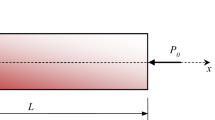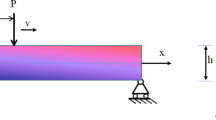Abstract
We proposed an original method to investigate the problem of torsion of anisotropic cross-section. We implemented an energy method to calculate the stress function represented by infinite series of trigonometric functions adapted to rectangular cross-section. After validation, we implemented a parametric sensitivity study to investigate the influence of the cross-section aspect ratio and the anisotropy level on the stress function, the strain energy density and the torsion stiffness. The process showed a fast convergence with a very good accuracy. The model showed a potential interest for the experimental identification of anisotropic material properties.
Similar content being viewed by others

References
Allen D.N.: Relaxation Methods. McGraw-Hill, London (1955)
Benveniste Y.: A new approach to the application of Mori–Tanaka’s theory in composite materials. Mech. Mat. 6, 147–157 (1987)
Ely J.F., Zienkiewicz O.C.: Torsion of compounds bars—a relaxation solution. Int. J. Mech. Sci. 1, 356–365 (1960)
Estivalèzes E., Couteau B., Darmana R.: 2D calculation method based on composite beam theory for the determination of local homogenized stiffnesses of long bones. J. Biomech. 34(2), 277–283 (2001)
Herrman L.R.: Elastic analysis of irregular shaped prismatic beams by the method of finite elements. J. Eng. Mech. Div. Prc. ASCE 94(EM4), 965–983 (1968)
Horgan C.O., Chan A.M.: Torsion of functionally graded isotropic linearly elastic bars. J. Elast. 52, 181–199 (1999)
Lekhnitshii S.G.: Theory of Elasticity of an Anisotropic Body. Mir Publishers, Moscow (1981)
Meirovitch L.: Elements of Vibration Analysis. McGraw-Hill, New York (1975)
Manson, W.E., Herrman, L.R.: Elastic Analysis of Irregular Shaped Prismatic Beams by the Method of Finite Elements. Davis, Dept. Civ. Eng. University of California, Tech. Report no 67-1 (1967)
Muskhelishvilli N.I.: Some Basic Problems of the Mathematical Theory of Elasticity, pp. 561. Noordhoff, Groningen (1953)
Pereira, J.C.: Contribution à l’étude du comportement mécanique des structures en matériaux composites: caractéristiques homogénéisées des poutres composites, comportement dynamique des coques composites. PhD thesis, INSA Lyon, France (1995)
Rooney F.J., Ferrari M.: Tension, bending and flexure of functionally graded cylinders. Int. J. Solids Struct. 38, 413–421 (2001)
Shaw, F.S.: The torsion of solid and hollow prisms in the elastic and plastic range by relaxation methods. Austral. Counc. Aeronaut., Sydney, 92 p, Report ACA-11, 38 (1944)
Sokolnikoff I.S.: Mathematical Theory of Elasticity. McGraw-Hill, USA (1956)
Southwell R.V.: Relaxation Methods in Theoretical Physics, pp. 85. Clarendon press, Oxford (1946)
Swider P., Jacquet-Richardet G., Pereira J.C.: Interactions between numerical and experimental approaches in composite structure dynamics. Compos. Struct. 43(2), 127–135 (1998)
Timoshenko S., Goodier J.N.: 1934 reissued 1987. Theory of Elasticity. McGraw-Hill, USA (1934)
Zienkiewicz O.C., Cheung Y.K.: Finite elements in the solution of field problems. Engineer 8, 507–510 (1965)
Author information
Authors and Affiliations
Corresponding author
Rights and permissions
About this article
Cite this article
Swider, P., Briot, J. & Estivalèzes, E. A solution of torsional problem by energy method in case of anisotropic cross-section. Arch Appl Mech 81, 801–808 (2011). https://doi.org/10.1007/s00419-010-0450-7
Received:
Accepted:
Published:
Issue Date:
DOI: https://doi.org/10.1007/s00419-010-0450-7



